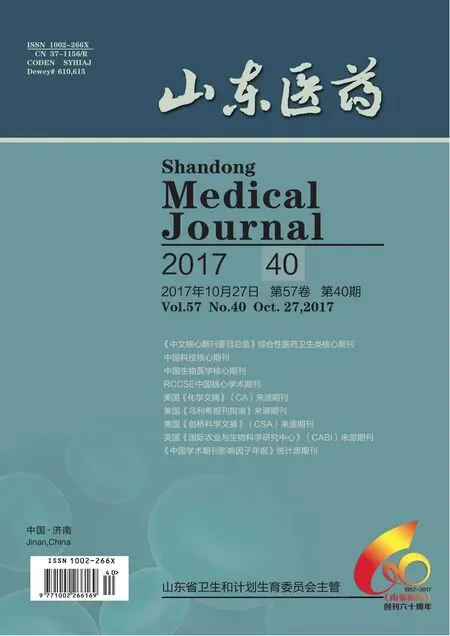受体CX3CR1基因敲除对同种异系小鼠气管移植术后排斥反应的影响
2017-04-05关向前刘毛妮
关向前,刘毛妮
(1安徽省立医院,合肥 230001;2安徽中医药大学第一附属医院)
受体CX3CR1基因敲除对同种异系小鼠气管移植术后排斥反应的影响
关向前1,刘毛妮2
(1安徽省立医院,合肥 230001;2安徽中医药大学第一附属医院)
目的探讨趋化因子受体CX3CR1基因敲除对同种异系小鼠气管移植后排斥反应的影响。方法将24只小鼠分为同系移植对照组、异系移植对照组、基因敲除移植组,每组各4对。基因敲除移植组、同系移植对照组受体和供体均为BABL/c小鼠;异系移植对照组供体为BABL/c小鼠,受体为C57BL/6小鼠;基因敲除移植组供体为BABL/c小鼠,受体为CX3CR1基因敲除小鼠。各组均行颈背部气管移植,每只受鼠移植2段气管。4周后取出各受鼠移植气管段,石蜡包埋,切片,HE染色,镜下观察管腔纤维化阻塞情况;采用ELISA法检测受鼠血清高迁移率族蛋白1(HMGB1)水平。结果同系移植对照组8个移植气管段均无管腔阻塞,阻塞分数为0;异系移植对照8个移植气管段均出现管腔阻塞,移植气管管腔内充满黏液,镜下见管腔内有大量增生的成纤维细胞,阻塞分数为8.0;受体敲除移植组8个移植气管段中1个出现管腔受挤压、扭曲,1个阻塞不明显,其余6个均未出现较明显的管腔纤维化阻塞,移植气管管腔内充满黏液,镜下见管腔内有大量增生的成纤维细胞,阻塞分数为0.96。移植后4周同系移植对照组、异系移植对照组、基因敲除移植组血清HMGB1水平分别为(29.8±1.6)、(83.6±1.4)、(19.8±0.9)ng/mL,基因敲除移植组明显低于异系移植对照组(P<0.05),但与同系移植对照组比较,P>0.05。结论受体CX3CR1基因敲除可明显减轻气管移植后排斥反应。
CX3CR1;基因敲除;气管移植;排斥反应;小鼠
肺移植是终末期肺疾病最有效的治疗方式,但目前其移植生存率明显低于其他实质器官移植[1]。肺移植后排斥反应主要是以气管为靶点的宿主抗移植物免疫排斥反应。气管排斥反应主要表现为气道炎症、气道重塑以及气道上皮细胞向间充质细胞的转化,气道上皮细胞主要转化为成纤维细胞;成纤维细胞进一步增殖,并分泌大量弹性纤维,阻塞气管腔,导致闭塞性细支气管炎(OB)[2]。OB是影响肺移植受者长期存活的首要因素[3,4],抑制OB自然成为提高肺移植存活率的有效方法[5~7]。CX3CR1是趋化因子受体,主要在巨噬细胞、单核细胞、中性粒细胞和T淋巴细胞表达。CX3CR1及其配体被证实具有调控炎性细胞向炎症部位迁移和招募的作用[8],同时CX3CR1具有调节单核细胞分化、增殖的作用,且在肿瘤转移及肝脏纤维化形成中有重要的促进作用[9~11]。上述提示CX3CR1可能参与了移植后OB的发生过程。为验证这一推测,我们观察了趋化因子受体CX3CR1基因敲除对同种异系小鼠气管移植后排斥反应的影响。现报告如下。
1 材料与方法
1.1 材料 实验动物:24只小鼠均以常规条件饲养于安徽医科大学动物实验中心SPF级动物房。纯系BALB/c小鼠和C57BL/6小鼠由华中科技大学同济医学院实验动物中心提供,许可证号:SCXK(鄂)2004-0007。CX3CR1-基因敲除的C57BL/6小鼠由美国Jackon实验室提供。
1.2 颈背部气管移植 将24只小鼠分为三组,每组各4对。同系移植对照组受体和供体均为BABL/c小鼠;异系移植对照组供体为BABL/c小鼠,受体为C57BL/6小鼠;基因敲除移植组供体为BABL/c小鼠,受体为CX3CR1基因敲除小鼠。三组均行颈背部气管移植。手术前将供鼠脱颈处死,放入装有 75%乙醇的烧杯中 15 min,杯口密封。取出 8 个软骨环长度的气管,放入盛有生理盐水的培养皿中,用 1 mL注射器轻轻冲洗管腔2~3次。受鼠麻醉后,剃去受鼠颈背部毛发,碘酒消毒皮肤,然后在颈背部两侧用消过毒的眼科剪剪出两个 2~3 mm裂口(将皮剪破即可,不要剪过深),并沿前爪方向在皮下捅出一条皮下遂道(注意保持皮肤的完整性)。将从供鼠取下的气管段用消过毒的弯镊放入皮下遂道底部,缝合裂口(手术过程在超净台内进行)。手术后,将受鼠放入清洁级动物房饲养,每 2 天观察受鼠的精神状态和手术部位感染及毛发恢复情况,并适当添加繁殖饲料,更换水。
1.3 相关指标观察
1.3.1 移植气管阻塞程度 各组均于移植4周取出各移植气管,石蜡包埋,切片,HE染色,光镜下观察气管腔纤维化闭塞情况,计算各移植气管阻塞分数。移植气管段阻塞分数=管腔阻塞面积/管腔总面积,完全阻塞则阻塞分数为1.0,完全不阻塞则阻塞分数为0.0。各组移植气管阻塞程度为该组各个移植气管段阻塞分数之和。
1.3.2 血清高迁移率族蛋白1(HMGB1)水平 移植4周抽取各组静脉血,分离血清,采用ELISA法检测HMGB1,操作按试剂盒说明书进行。

2 结果
2.1 各组移植气管阻塞情况比较 同系移植对照组8个移植气管段均无管腔阻塞,阻塞分数为0;异系移植对照组8个移植气管段均出现管腔阻塞,移植气管管腔内充满黏液,镜下见管腔内有大量增殖的成纤维细胞,阻塞分数为8.0;基因敲除移植组8个移植气管段中1个出现管腔受挤压、扭曲,1个阻塞不明显,其余6个均未出现较明显的管腔纤维化阻塞,移植气管管腔内充满黏液,镜下见管腔内有大量增生的成纤维细胞,阻塞分数为0.96。
2.2 各组血清HMGB1水平比较 移植后4周基因敲除移植组血清HMGB1水平分别为(29.8±1.6)、(83.6±1.4)、(19.8±0.9)ng/mL。基因敲除移植组血清HMGB1水平低于异系移植对照组(P<0.05),但与同系移植对照组比较P>0.05。
3 讨论
器官移植排斥反应的本质是受体免疫系统针对来自供体的移植物的攻击反应及免疫应答[12]。气管移植后发生的OB是免疫和/非免疫因素所造成的细小支气管炎症反应性损伤及异常修复过程,多数学者认为免疫排斥反应是其首要原因[1]。气管移植排斥的主要靶器官是气道上皮,即受者针对移植物气管上皮发生相应的应答反应。 OB发生后气道上皮胶原沉积和广泛的纤维组织增生,最终阻塞气管[13~15]。
OB的发展进程从时间上可以分为上皮损伤期、炎症浸润期和纤维化增生期[16,17]。炎症浸润期属于过渡阶段,是由于上皮损伤激活固有免疫系统,引起巨噬细胞、中性粒细胞等炎性细胞向特定部位迁移,并分泌、释放多种炎性因子,促使上皮细胞间充质转化的发生,为纤维化阻塞的形成奠定基础[18~20]。
目前气管移植动物模型主要分为原位移植和异位移植。本研究我们建立了小鼠颈背部气管移植模型,属于异位移植,此模型稳定,操作方便,感染率低。实验中我们选择趋化因子受体CX3CR1作为研究靶标,试图通过在炎症浸润期干扰炎性细胞的迁移和浸润来抑制移植后排斥反应。本研究结果显示,基因敲除移植组和同系对照组气管阻塞情况明显好于异系对照组。基因敲除移植组和同系对照组血清HMGB1水平明显低于异系对照组。表明受体CX3CR1基因敲除可明显减轻气管移植后排斥反应。对此结果,我们初步的解释是:CX3CR1基因敲除主要影响了炎症浸润期巨噬细胞、中性粒细胞等炎性细胞的迁移,从而抑制整个OB的发展进程。其具体机制和信号通路尚有待更进一步、更深入的研究。
HMGB1是一种核DNA结合蛋白,被称为“DNA伴侣”,参与DNA的复制、转录及修饰过程。在细胞处于炎症、感染、损伤情况下,HMGB1即从细胞内主动释放至细胞外,参与细胞(或机体)应激过程,如免疫应答或移植排斥,故亦被称为损伤式分子蛋白(DAMP)。据文献报道,在同种小鼠气管移植排斥过程中,HMGB1分子亦从气管上皮细胞内转移至细胞外,通过RAGE/NF-κB/TGF-β信号途径参与移植后闭塞性气管炎的发生发展,其在移植受体血清中的表达水平也是明显升高的[21]。本研究采用受鼠血清HMGB1水平来间接反应移植排斥情况,结果发现与病理检测结果一致。但HMGB1与CX3CR1在促进气管移植排斥过程中的内在联系在本研究中未得以揭示,尚需要更深入的研究。
[1] 汪进益,曹浩,洪暄.闭塞性细支气管炎模型大鼠微小RNA差异表达谱分析[J].中国组织工程研究,2014,18(18):2855-2860.
[2] 朱学海,魏翔,吴黎.鼠异位气管移植模型中核转录因子NF-κB激活MCP-1诱导闭塞性细支气管炎的研究[J].医学分子生物学杂志,2010,7(5):418-424.
[3] 王林毛,吴凯,高文.异位气管移植模型中上皮细胞的增殖与凋亡[J].中国组织工程研究杂志,2011,15(18):3288-3292.
[4] 王丽凤,许江南,夏思思.IL-17A对小鼠气管移植后早期气道上皮细胞的影响[J]. 中华心血管外科杂志,2015,31(1):24-27.
[5] Cao H, Lan Q, Shi Q, et al. Anti-IL-23 antibody blockade of IL-23/IL-17 pathway attenuates airway obliteration in rat orthotopic tracheal transplantation[J]. Int immunopharmacol, 2011,11(5):569-578.
[6] Borthwick LA, Parker SM, Brougham KA, et al. Epithelial to mesenchymal transition (EMT) and airway remodelling after human lung transplantation[J]. Thorax, 2009,64(5):770-777.
[7] Gillen JR, Zhao Y, Harris DA, et al. Rapamycin blocks fibrocyte migration and attenuates bronchiolitis obliterans in a murine model[J]. Ann Thorac Surg, 2013,95(5):1768-1775.
[8] Tang A, Gan Y, Liu Q, et al. CX3CR1 deficiency suppress activation and neurotoxicity of microglia/macrophage in experimental ischemic stroke[J]. J Neuroinflammation, 2014,11(26):13-26.
[9] Zhang R, Zhu W, Mao S, et al. High-concentrate feeding upregulates the expression of inflammation-related genes in the ruminal epithelium of dairy cattle[J]. J Anim Sci Biotechnol, 2016, 21(13):21-33.
[10] Liaskou E, Jeffery LE, Trivedi PJ, et al. Loss of CD28 expression by liver-infiltrating T cells contributes to pathogenesis of primary sclerosing cholangitis[J]. Gastroenterology, 2014,147(1):221-232.
[11] Donnelly DJ, Lonqbrake EE, Shawler TM, et al. Deficient CX3CR1 signaling promotes recovery after mouse spinal cord injury by limiting the recruitment and activation of Ly6Clo/iNOS+ macrophages[J]. Spine J, 2011,31(27): 9910-9922.
[12] Guo YW, Gu HY, Abassa KK, et al. Successful treatment of ileal ulcers caused by immunosuppressants in two organ transplant recipients[J]. World J Gastroenterol, 2016,22(24):5616-5622.
[13] Zhao Y, Gillen JR, Harris DA, et al. Treatment with placenta-derived mesenchymal stem cells mitigates development of bronchiolitis obliterans in a murine model[J]. J Thorac Cardiovasc Surg, 2014,147(5):1668-1677.
[14] Donq M, Wang X, Zhao YX, et al. Protein-DNA array-based identification of transcription factor activities differentially regulated in obliterative bronchiolitis[J]. Int J Clin Exp Pathol, 2015,8(6):7140-7148.
[15] Khan MA, Jiang X, Dhilon G, et al. CD4+T cells and complement independently mediate graft ischemia in the rejection of mouse orthotopic tracheal transplants[J]. Circ Res, 2011,109(11):1290-1301.
[16] Shah PD, West EE, Whitlock AB, et al. CD154 deficiency uncouples allograft CD8+T-cell effector function from proliferation and inhibits murine airway obliteration[J]. Am J Transplant, 2009,9(12):2697-2706.
[17] Lau CL, Zhao Y, Kron IL, et al. The role of adenosine A2A receptor signaling in bronchiolitis obliterans[J]. Ann Thoral Surq, 2009,88(4):1071-1078.
[18] Okazaki M, Gelman AE, Tietjens JR, et al. Maintenance of airway epithelium in acutely rejected orthotopic vascularized mouse lung transplants[J]. Am J Respir Mol Biol, 2007,37(6):625-630.
[19] Suzuki H, Lasbury ME, Fan L, et al. Role of Complement Activation in Obliterative Bronchilitis post lung transplantation[J]. J immunol, 2013,191(8):312-321.
[20] Zhao J, Wang Y, Wakaham A, et al. XB130 deficiency affects tracheal epithelial differentiation during airway repair[J]. PloS One, 2014,9(10):2317-2324.
[21] He L, Sun F, Wang Y, et al. HMGB1 exacerbates bronchiolitis obliterans syndrom via RAGE/NF-κB/HPSE signaling to enhance latent TGF-β release from ECM[J]. Am J Transl Res, 2016,8(5):1971-1984.
EffectofCX3CR1geneknockoutonrejectionofallogeneicmiceaftertrachealtransplantation
GUANXiangqian1,LIUMaoni
(1AnhuiProvincialHospital,Hefei230001,China)
ObjectiveTo investigate the effect of chemokine receptor CX3CR1 gene knockout on rejection of allogeneic mice after tracheal transplantation.MethodsTwenty-four mice were divided into three groups: homologous control group, allogenic control group, and gene knockout transplantation group with 4 pairs in each. In the homologous control group, all donor mice and recipient mice were BALB/c mice. In the allogenic control group, donor mice were BALB/c mice, and recipient mice were C57BL/6 male mice. In the gene knockout transplantation group, donor mice were BALB/c mice, and recipient mice were CX3CR1 knockout mice (C57BL/6 background). Trancheal transplantation operation was performed in all groups, and each recipient mouse was transplanted with 2 tracheas. At week 4 after transplantation, the tracheal grafts were removed and the pathological change was detected with HE staining. Meanwhile, the serum high-mobility group box 1 protein (HMGB1) levels in the recipients of each group were detected with ELISA.ResultsHE staining showed that there was no fibrosis in the tracheal grafts from the homologous control group, and the blocking score was 0. All tracheal grafts from the allogenic control group had fibrosis, and the blocking score was 8.0. In the gene knockout transplantation group, 1 tracheal graft had fibrosis, and the blocking score was only 0.96. At week 4 after transplantation, the HMGB1 levels in the homologous control group, allogenic control group, and gene knockout transplantation group were (29.8±1.6), (83.6±1.4), and (19.8±0.9) ng/mL, and the HMGB1 level was lower in the gene knockout transplantation group than in the allogenic control group (P<0.05), but no significantly difference was found between the homologous control group and the gene knockout transplantation group (P>0.05).ConclusionReceptor CX3CR1 knockout can significantly reduce the rejection after tracheal transplantation.
CX3CR1; gene knockout; trachea transplantation; rejection; mice
国家自然科学基金资助项目(30972779)。
关向前(1983-),男,硕士,主要研究方向:移植免疫学和细胞免疫学。E-mail: gxq466216@163.com
10.3969/j.issn.1002-266X.2017.40.007
R617
A
1002-266X(2017)40-0026-03
2016-09-04)
